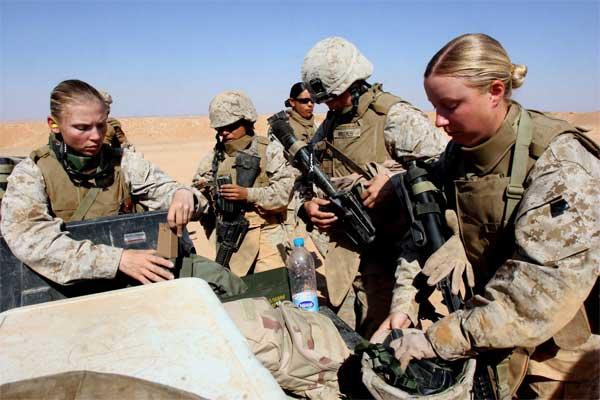"The
average female army recruit is 5.8 inches shorter, 31.7 pounds lighter,
has 37.4 fewer pounds of muscle and 5.7 more pounds of fat than the
average male recruit."
"She has only 55 percent of the upper-body strength and 72 percent of the lower-body strength."
"The average 20-to30 year-old woman has the same aerobic capacity as a 50-year-old man."
1992 Presidential commission on the Assignment of Women in the U.S. Armed Forces
"Currently, women have higher rates of
discharge for medical disability that prevents them from finishing their
enlistment, or re-enlistment. Stress and muscular deterioration in
women comes on faster and harder due to the heavy gear and physical
duress in the field environment. Muscle
atrophy, hip displacement, and arthritis in knees and joints are common
ailments. Spinal compression occurs from long periods of heavy combat
loads." Retired Marine Gunnery Sergeant Jessie Jane Duff
 |
|
So,
is it not beyond puzzling, stretching common sense to its limits, that a
natal male assigning himself a female role in life is able legally to
compete with women in various sport categories with that level of
unequal advantage. Claiming oneself to be female, not the gender
identified and assigned at birth allows men who identify as women to
enter women's public washrooms, be incarcerated in women's sections of
prisons, compete in women's sports because the inconvenient facts of
unfair advantage are held to be prejudicial to the welfare of the trans
community.
Decades
ago, during the early years of women's liberation, when women insisted
there should be no male-dominated professions that women too could not
enter and become proficient at, from elite corporate offices to
conducting an orchestra, opportunities opened. The gates guarding male
dominance in culture, competitive sport, engineering, medicine, science,
exploration, fire-fighting and police services and finally national
defence came down one after another. Where women traditionally in
Western societies did not serve in combat roles, they could enter the
military in less 'forward' roles.
 |
| Marines with the Lioness Program refill their rifle magazines during the
live-fire portion of their training at Camp Korean Village, Iraq. (Photo By: Sgt. Jennifer Jones) |
Their
goal partially accomplished, women strove to convince that no positions
in the military should be closed to them, and they eventually won that,
too. And something odd happened to the confidence that women could be
deployed in active combat roles, despite their gendered physical
differences from men in sheer brawn. When the U.S. military began
integrating men and women in combat roles in 2012, Capt. Katie Petronio
published an essay that stirred controversy.
She was an elite college athlete, an obvious candidate scoring "far above average in all female-based physical fitness tests" when she was undergoing Marine Corps training. The essay she wrote that was published in the Marine Corps Gazette advised: "We
are not all created equal, and attempting to place females in the
infantry will not improve the Marine Corps as the nation's
force-in-readiness or improve our national security".
Well,
what might have happened to produce that sentiment? Capt. Patronio had
been deployed in a variety of combat hot spots. In Afghanistan the
stress of ongoing combat operations over several months saw her legs
atrophy and buckle, her mobility declining as the deployment took its
unexpected toll on her fit body. She lost 17 pounds, and developed
polycystic ovarian syndrome, the outcome of which was to render her
sterile.
 |
Capt. Katie Petronio
|
"I
understand that everyone is affected differently [But] I can say from
firsthand experience in Iraq and Afghanistan, and not just emotion that
we haven't even begun to analyze and comprehend the gender-specific
medical issues and overall physical toll continuous combat operations
will have on females."
"...some of these [female] Marines may feel qualified for
the chance of taking on the role of 0302 [Infantry Officer]. In the end,
my main concern is not whether women are capable of conducting combat
operations, as we have already proven that we can hold our own in some
very difficult combat situations; instead, my main concern is a question
of longevity. Can women endure the physical and physiological rigors of
sustained combat operations, and are we willing to accept the attrition
and medical issues that go along with integration?"
Former U.S. infantry officer Brian Mitchell who wrote Women in the Military: Flirting with Disaster,
pointed out in 1997 that shortfalls in recruit are insufficient reason
to recruit women; in fact recruiting women is the cause of shortfalls: "The more attractive you make the military look to women, the less attractive you make it look to men".



<< Home